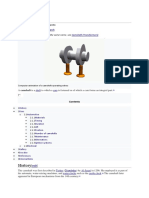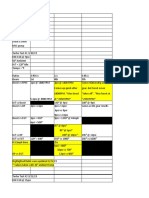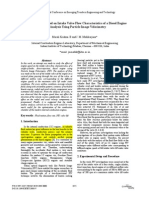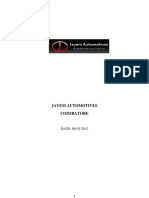Engine Building Formulas
Uploaded by
Abhijeet FeelproudEngine Building Formulas
Uploaded by
Abhijeet FeelproudFormulas Predicting Power BHP = PLAN/33,000 P is brake mean effective pressure, in PSI L is piston stroke, in feet A is the area
of one piston, in square inches N is the number of power strokes per minute Brake Mean Effective Pressure (BMEP) 2-Stroke BMEP = (HP x 6500)/(L x RPM) 4-Stroke BMEP = (HP x 13000)/(L x RPM) Piston Acceleration Piston Speed Cm = .166 x L x N Cm is mean piston speed, in feet per minute L is stroke, in inches N is crankshaft speed, in RPM L = Displacement in Liters i.e., 80 cc = .08 Liters 1 ci. = 16.39 cc
Piston Stroke Motion S = R cos X + L cos Z S = the distance piston wrist pin is from center Gmax = ((N^2 x L)/2189) x (1 + 1/(2A)) of crankshaft Gmax is maximum piston acceleration, in feet R = the radius of the crankshaft wrist pin per second squared L = the length of the connecting rod N is crankshaft speed, in RPM X = the angle of the wrist pin L is stroke, in inches Z = the angle of the connecting rod A is the ratio of connecting rod length, between or centers, to stroke sin X = R/L sin Z Piston Travel vs. Crank Rotation d = ((S/2) + L) - (S/2 cos X) - L sin[cos-1 (S/2L sin X)] S = Stroke (mm) L = Connecting Rod Length (mm) X = Crank Angle Before or After TDC (deg) Note: (L) Rod Length is usually 2 times the (S) Stroke OR For Spreadsheets and some Calculators HT = (r + c) - (r cos (a)) - SQRT(c^2 - (r sin (a))^2) r = s/2 dtor = PI/180 a = d x dtor HT = The height of piston r = The stroke divided by 2 c = The rod length a = The crank angle in radians d = The crank angle in degrees dtor = Degrees to Radians Exhaust Systems Tuned Length Lt = (Eo x Vs) / N Lt is the tuned length, in inches Eo is the exhaust-open period, in degrees Vs is wave speed in feet per second (1700 ft/sec at sea level) N is crankshaft speed, in RPM Length of Curved Pipe L = R x .01745 x Z L is length R is radius of the pipe bend Z is the angle of the bend Diffuser Proportions D2 = SQRT( D1^2 x 6.25 ) D2 is the diffuser outlet diameter D1 is the diffuser inlet diameter 6.25 is the outlet/inlet ratio constant Baffle Cones Lr = Le/2 Lr is mean point of the reflection inside the baffle cone Le is the length of the baffle cone
Port Open Time T = ( 60/N ) x ( Z/360 ) or T = Z/( N x 6) T is time, in seconds N is crankshaft speed, in RPM Z is port open duration, in degrees Carburetor Throttle Bore Diameter D = K x SQRT( C x N ) D is throttle bore diameter, in millimeters K is a constant ( approx. 0.65 to 0.9, derive from existing carburetor bore) C is cylinder displacement, in liters N is RPM at peak power Resonance Effects F = Vs / 2 * the square root of A / Vc (L + 1/2 the square root of A Vs is the sonic speed Uusually about 1100 ft/sec) A is the cross-sectional area of the inlet L is the inlet pipe length Vc is the flask (crankcase) volume Torque 1.00 lb-ft = 0.138 kg-m = 1.35 N-m 1.00 kg-m = 7.23 lb-ft. = 9.81 N-m 1.00 N-m = 0.102 kg-m = 0.737 lb-ft Distance 1 in = 2.54 cm = 0.0000158 mi = 0.0000254 km 1 cm = 0.394 in = 0.00000621 mi = 0.00001 km 1 ft = 30.5 cm = 0.000189 mi = .000305 km 1 mi = 63,360 in = 160,934.4 cm = 1.609 km 1 km = 0.621 mi = 100,000 cm = 3281 ft Temperature F = 9 / 5 x C + 32 C = 5/9 (F - 32) K = C + 273.4
Compression Ratio CR = ( V1 + V2 ) / V2 CR is compression ratio V1 is cylinder volume at exhaust closing V2 is combustion chamber volume Crankcase Volume Primary compression ratio = Case Volume @ TDC / Case Volume at BDC or CRp = V1 + V2 / V1 CRp is the primary compression ratio V1 is crankcase volume @ BDC V2 is piston displacement Average Exhaust Temperature Determine the exhaust gas temperature in Kelvin (k = C + 273.15). This is usually a function of the engine's BMEP. Mass 1.00 lb = 0.454 kg = 4.45 N 1.00 kg = 2.20 lbs = 9.81 N 1.00 N = 0.102 kg = 0.220 lb Pressure 1.00 bar = 14.5 psi = 1.02 kg/sq-cm = 100 kPa 1.00 psi = 0.069 bar = 0.070 kg/sq-cm = 6.89 kPa 1.00 kg/sq-cm = 0.980 bar = 14.2 psi = 98.1 kPa 1.00 kPa = 0.010 bar = 0.145 psi = 0.010 kg/sqcm Area / Volume 1.00 sq-in = 6.452 sq-cm 1.00 sq-cm= 0.155 sq-in 1.00 cu-in = 16.387 cc 1.00 cc = 0.0610 cu-in
Power 1.00 HP = 746 W torque (lb-ft) = 5252 x hp / rpm hp = rpm x torque (lb-ft) / 5252 The Weight of Air 14.7 lbs. per sq. inch at sea level.
Air Density Calculation StdAirDensity = 1.22556 and is defined at 59.0F degrees, 0.0% humidity, and 29.92 inches on the barometer. Temp_c = (Temp-32.0) * 5.0 / 9.0; Temp_k = Temp_c + 273.0; Baro_mb = Barometer / (29.92 / 1013.0); Baro_pa = Baro_mb * 100.0; SaturationPressure_mb = 6.11 * pow(10,(7.5*Temp_c)/(237.7+Temp_c)); VaporPressure_mb = Humidity * SaturationPressure_mb / 100.0; TempVirtual_k = Temp_k / (1.0 - (VaporPressure_mb/Baro_mb)*(1.-0.622)); // D = P/(T*R) AirDensity = Baro_pa / (TempVirtual_k*GasConstant); % Std Density = AirDensity/StdAirDensity*100 Additional Conversion Factors 1 Centimeter - 0.0328084 foot; 0.393701 inch 1 Circular Mil - 7.853982 x 10 to the negative seventh square inches; 5.067075 x 10 to the negative sixth square centimeters 1 Meter - 1.093613 yards; 3.280840 feet; 39.37008 inches 1 Mile (statute) - 1.609344 kilometers 1 Ounce (U.S. fluid) - 1.804688 cubic inches; 29.573730 cubic centimeters
1 Cubic Centimeter - 0.061024 cubic inch; 0.270512 dram (U.S. fluid); 16.230664 minims (U.S.); 0.999972 milliliter 1 Ounce (avoirdupois) - 28.349523 grams
1 Cubic Foot - 0.803564 bushel (U.S.); 1 Ounce (apothecary or troy) - 31.103486 7.480520 gallons (U.S. liquid); 0.028317 cubic grams meter; 28.31605 liters 1 Pint (U.S. liquid) - 0.473163 liter; 473.17647 1 Cubic Inch - 16.387064 cubic centimeters cubic centimeters 1 Cubic Meter - 35.314667 cubic feet; 264.17205 gallons (U.S. liquid) 1 Foot - 0.3048 meter 1 Gallon (U.S. liquid) - 0.1336816 cubic foot; 0.832675 gallon (British); 231 cubic inches; 0.0037854 cubic meter; 3.785306 liters 1 Grain - 0.06479891 gram 1 Radian - 57.295779 degrees 1 Gram - 0.00220462 pound (avoirdupois); 0.035274 ounce (avoirdupois); 15.432358 1 Rod - 5.0292 meters 1 Pound (avoirdupois) - 0.453592 kilogram; 453.59237 grams 1 Pound (apothecary or troy) - 0.3732417 kilogram, 373.24172 grams 1 Quart (U.S. dry) - 1.10119 liters 1 Quart (liquid) - 0.946326 liter
grains 1 Square Centimeter - 0.155000 square inch 1 Hectare- 2.471054 acres; 1.07639 x 10 to the fifth square feet 1 Inch - 2.54 centimeters 1 Kilogram - 2.204623 pounds (avoirdupois) 1 Kilometer - 0.621371 mile (statute) 1 Liter - 0.264179 gallon (U.S. liquid);0.0353157 cubic foot; 1.056718 quarts (U.S. liquid) POWER - AC CIRCUITS Efficiency = 746 x Output HP / Input Watts 3 KW = Volts x Amps x PF x 1.732 / 1000 3 Amps = 746 x HP / 1.732 x Eff. x PF 3 Eff. = 746 x HP / 1.732 x Volts x Amps x PF 3 PF = Input Watts / Volts x Amps x 1.732 1 KW = Volts x Amps x PF / 1000 1 Amps = 746 x HP / Volts x Eff. x PF 1 Eff. = 746 x HP / Volts x Amps x PF 1 PF = Input Watts / Volts x Amps HP (3) = Volts x Amps x 1.732 x Eff. x PF / 746 HP (1) = Volts x Amps x Eff. x PF / 746 1 KW = 1000 Watts Eff. = Efficiency, PF = Power Factor, KW = Kilowatts, HP = Horsepower To figure miles per hour, multiply the engine RPM by the Wheel Diameter in inches and divide this by the Gear Ratio times 336 or MPH = RPM * wheel diameter (in inches) / gear ratio * 336 1 Square Foot - 0.09290304 square meter 1 Square Inch - 645.16 square millimeters 1 Square Meter - 10.763910 square feet 1 Square Yard - 0.836127 square meter 1 Ton (short) - 907.18474 kilograms 1 Yard - 0.9144 meter
POWER - DC CIRCUITS Torque = HP x 5280 / RPM HP = Torque X RPM / 5280 1 HP = 36 lb.in. @ 1750 RPM 1 HP = 3 lb. ft. @ 1750 RPM Eff. = Efficiency, HP = Horsepower OHMS LAW Volts (E) = Amps (I) x Ohms (R) Amps (I) = Volts (E) / Ohms (R) Ohms (R) = Volts (E) / Amps (I) R=Ohms, E=Volts, I=Amperes To figure engine speed (RPM), multiply by the Speed in MPH, by the rear axle gear ratio times 336. Divide this by the tire diameter in inches. or RPM = MPH * gear ratio * 336 / tire diameter
You might also like
- Massey Ferguson MF 245 Tractor Service Repair Manual PDF50% (2)Massey Ferguson MF 245 Tractor Service Repair Manual PDF10 pages
- Volumetric Efficiency and Mass Air Flow Calculation100% (1)Volumetric Efficiency and Mass Air Flow Calculation4 pages
- Introduction To Analytical Methods For Internal Combustion Engine Cam Mechanisms100% (1)Introduction To Analytical Methods For Internal Combustion Engine Cam Mechanisms11 pages
- Southern Marine Engineering Desk Reference: Second Edition Volume IiFrom EverandSouthern Marine Engineering Desk Reference: Second Edition Volume IiNo ratings yet
- MRT Technical Turbocharger Compressor Calculations100% (1)MRT Technical Turbocharger Compressor Calculations6 pages
- Nissan Motorsports Schematic Catalog PDFNo ratings yetNissan Motorsports Schematic Catalog PDF43 pages
- Polyethylene Tube Pressure Friction Loss CalculatorNo ratings yetPolyethylene Tube Pressure Friction Loss Calculator1 page
- 2010 FSAE Design Spec Sheet: Car No. SchoolNo ratings yet2010 FSAE Design Spec Sheet: Car No. School3 pages
- Engine Design and Operating Parameters: TopicNo ratings yetEngine Design and Operating Parameters: Topic42 pages
- N13201 - DR B R Ambedkar NIT Jalandhar - Supra Sae India 2014 - Design Spec SheetNo ratings yetN13201 - DR B R Ambedkar NIT Jalandhar - Supra Sae India 2014 - Design Spec Sheet4 pages
- 1) Effect of Engine Speed On Intake Valve Flow Characteristics of A Diesel EngineNo ratings yet1) Effect of Engine Speed On Intake Valve Flow Characteristics of A Diesel Engine6 pages
- Application of Magic Formula Tire Model To Motorcycle Maneuverability AnalysisNo ratings yetApplication of Magic Formula Tire Model To Motorcycle Maneuverability Analysis6 pages
- Mechanical Measurement and Metrology: Prepared by - Navroz NavodiaNo ratings yetMechanical Measurement and Metrology: Prepared by - Navroz Navodia20 pages
- Component Parts of Internal Combustion EnginesNo ratings yetComponent Parts of Internal Combustion Engines26 pages
- Constant Mass Flow Rate Supercharger Performance For FSAENo ratings yetConstant Mass Flow Rate Supercharger Performance For FSAE10 pages
- Entrepreneurship Development Training, Design Thinking Process, and Entrepreneurial Decision Making ProcessNo ratings yetEntrepreneurship Development Training, Design Thinking Process, and Entrepreneurial Decision Making Process17 pages
- How To Improve Internal Combustion Engine EfficiencyNo ratings yetHow To Improve Internal Combustion Engine Efficiency8 pages
- Annual Survey Checklist For Bulk CarrierNo ratings yetAnnual Survey Checklist For Bulk Carrier11 pages
- CNG 101: Basic Questions About Natural Gas As A Transportation FuelNo ratings yetCNG 101: Basic Questions About Natural Gas As A Transportation Fuel2 pages
- Automation of BMS System of Boiler Using PLC Ladder Logic100% (2)Automation of BMS System of Boiler Using PLC Ladder Logic52 pages
- Bobcat T870 Compact Track Loader Service Repair Manual (SN B47H11001 and Above)0% (1)Bobcat T870 Compact Track Loader Service Repair Manual (SN B47H11001 and Above)20 pages
- LNG Technical Presentation Ieaustralia Oil and Gas Division Perth October 2012No ratings yetLNG Technical Presentation Ieaustralia Oil and Gas Division Perth October 201212 pages
- Baltic Supramax Index (BSI) : Route Definitions: Route 1BNo ratings yetBaltic Supramax Index (BSI) : Route Definitions: Route 1B3 pages
- TROUBLE CODE: 61 - 4334 - 7 Trouble Code Test Testing: 2012 Freightliner Cascadia DETROIT DIESEL DD13 DDEC XNo ratings yetTROUBLE CODE: 61 - 4334 - 7 Trouble Code Test Testing: 2012 Freightliner Cascadia DETROIT DIESEL DD13 DDEC X3 pages
- Massey Ferguson MF 245 Tractor Service Repair Manual PDFMassey Ferguson MF 245 Tractor Service Repair Manual PDF
- Volumetric Efficiency and Mass Air Flow CalculationVolumetric Efficiency and Mass Air Flow Calculation
- Introduction To Analytical Methods For Internal Combustion Engine Cam MechanismsIntroduction To Analytical Methods For Internal Combustion Engine Cam Mechanisms
- Southern Marine Engineering Desk Reference: Second Edition Volume IiFrom EverandSouthern Marine Engineering Desk Reference: Second Edition Volume Ii
- MRT Technical Turbocharger Compressor CalculationsMRT Technical Turbocharger Compressor Calculations
- Polyethylene Tube Pressure Friction Loss CalculatorPolyethylene Tube Pressure Friction Loss Calculator
- N13201 - DR B R Ambedkar NIT Jalandhar - Supra Sae India 2014 - Design Spec SheetN13201 - DR B R Ambedkar NIT Jalandhar - Supra Sae India 2014 - Design Spec Sheet
- 1) Effect of Engine Speed On Intake Valve Flow Characteristics of A Diesel Engine1) Effect of Engine Speed On Intake Valve Flow Characteristics of A Diesel Engine
- Application of Magic Formula Tire Model To Motorcycle Maneuverability AnalysisApplication of Magic Formula Tire Model To Motorcycle Maneuverability Analysis
- Mechanical Measurement and Metrology: Prepared by - Navroz NavodiaMechanical Measurement and Metrology: Prepared by - Navroz Navodia
- Constant Mass Flow Rate Supercharger Performance For FSAEConstant Mass Flow Rate Supercharger Performance For FSAE
- Entrepreneurship Development Training, Design Thinking Process, and Entrepreneurial Decision Making ProcessEntrepreneurship Development Training, Design Thinking Process, and Entrepreneurial Decision Making Process
- How To Improve Internal Combustion Engine EfficiencyHow To Improve Internal Combustion Engine Efficiency
- CNG 101: Basic Questions About Natural Gas As A Transportation FuelCNG 101: Basic Questions About Natural Gas As A Transportation Fuel
- Automation of BMS System of Boiler Using PLC Ladder LogicAutomation of BMS System of Boiler Using PLC Ladder Logic
- Bobcat T870 Compact Track Loader Service Repair Manual (SN B47H11001 and Above)Bobcat T870 Compact Track Loader Service Repair Manual (SN B47H11001 and Above)
- LNG Technical Presentation Ieaustralia Oil and Gas Division Perth October 2012LNG Technical Presentation Ieaustralia Oil and Gas Division Perth October 2012
- Baltic Supramax Index (BSI) : Route Definitions: Route 1BBaltic Supramax Index (BSI) : Route Definitions: Route 1B
- TROUBLE CODE: 61 - 4334 - 7 Trouble Code Test Testing: 2012 Freightliner Cascadia DETROIT DIESEL DD13 DDEC XTROUBLE CODE: 61 - 4334 - 7 Trouble Code Test Testing: 2012 Freightliner Cascadia DETROIT DIESEL DD13 DDEC X

























































































